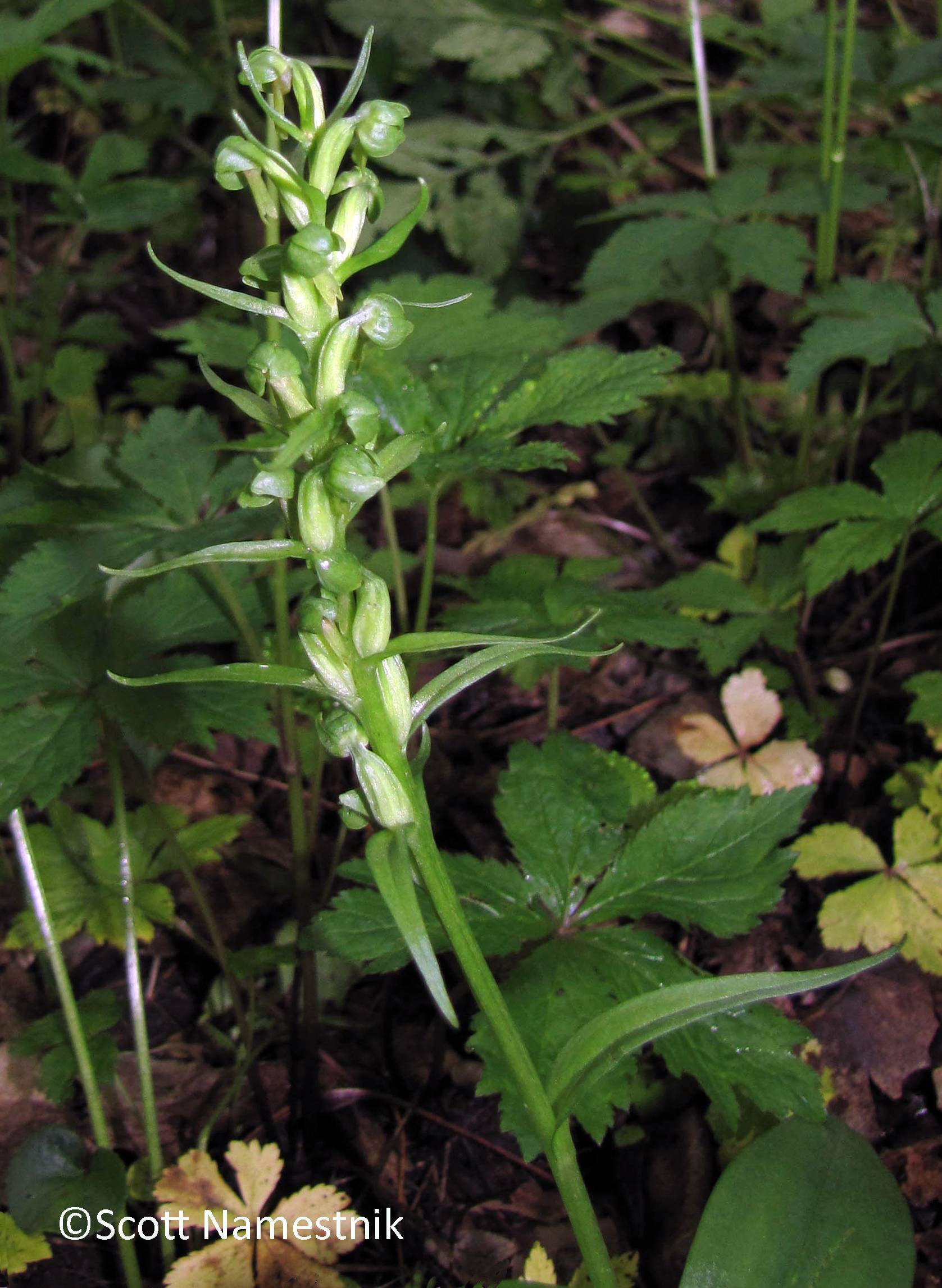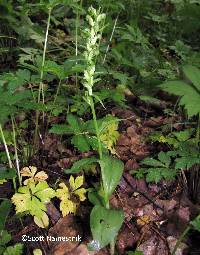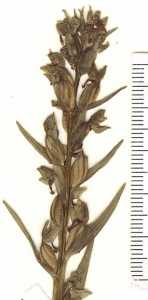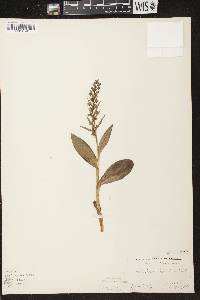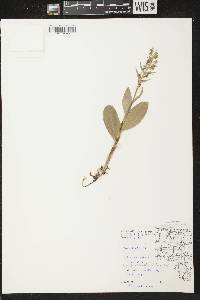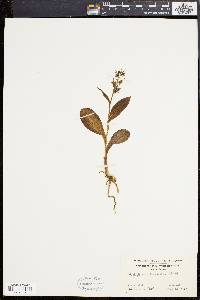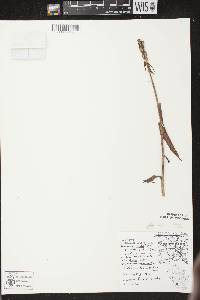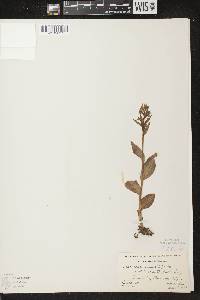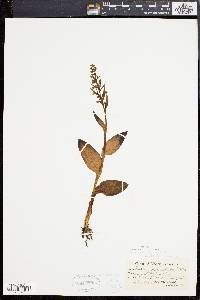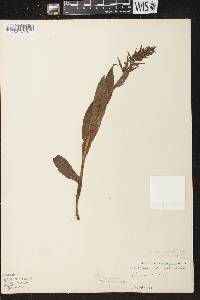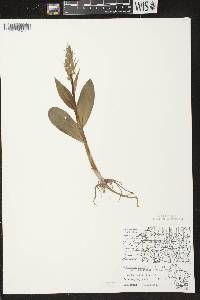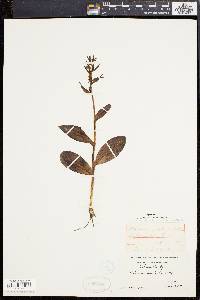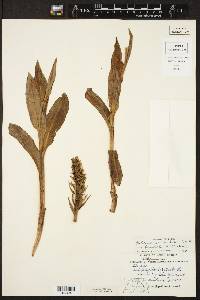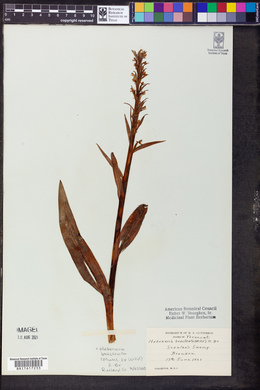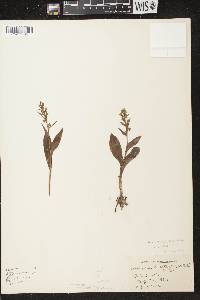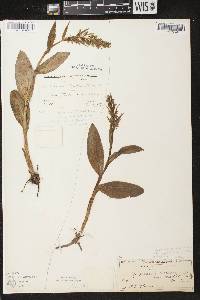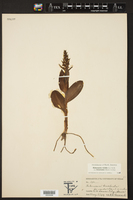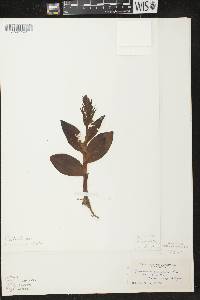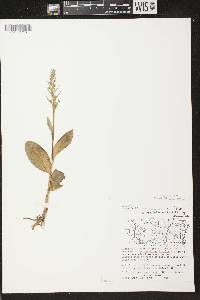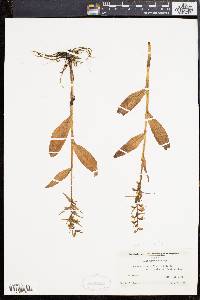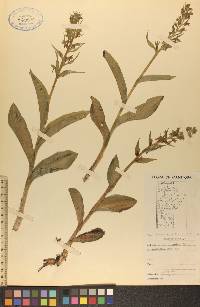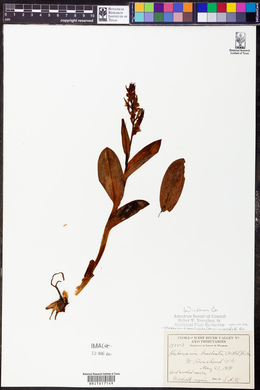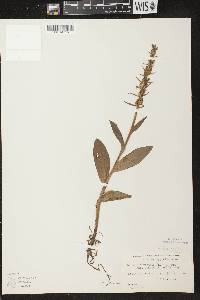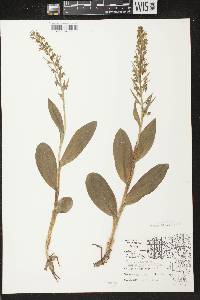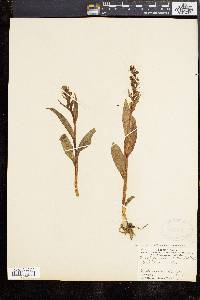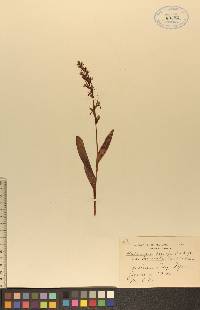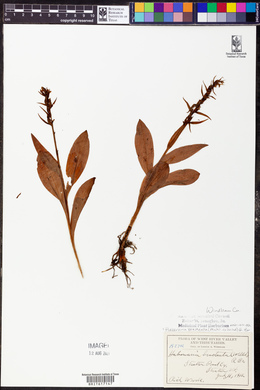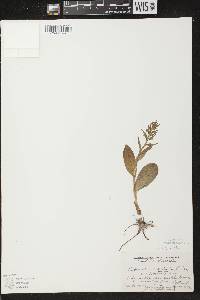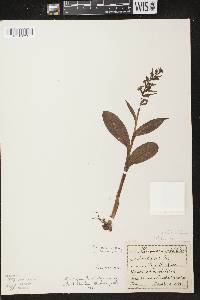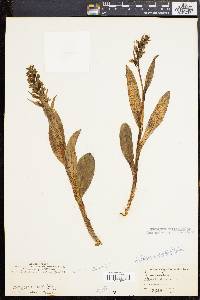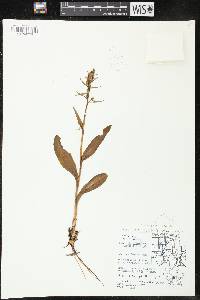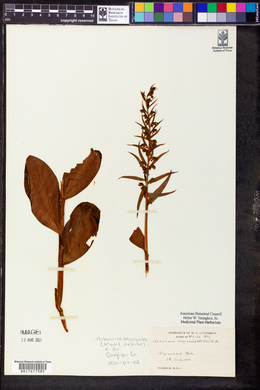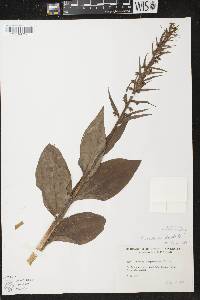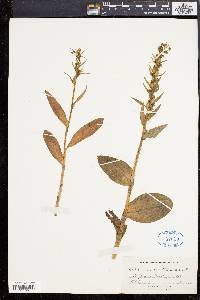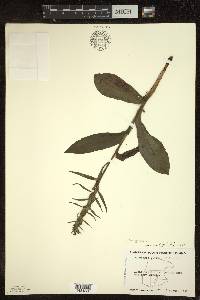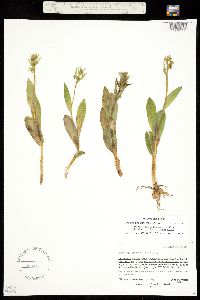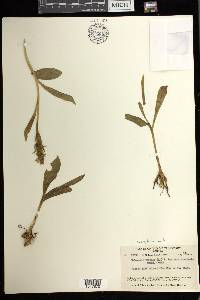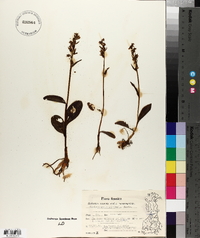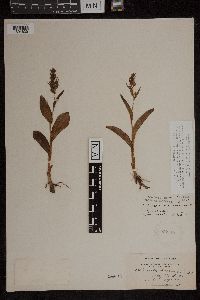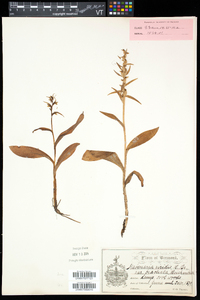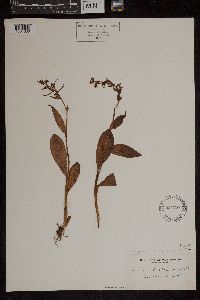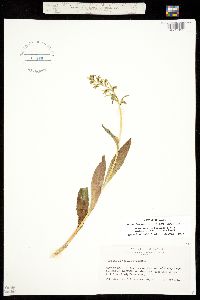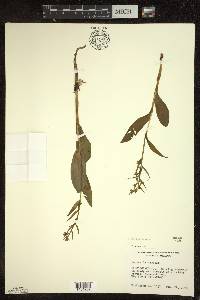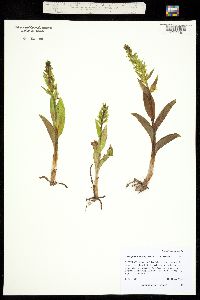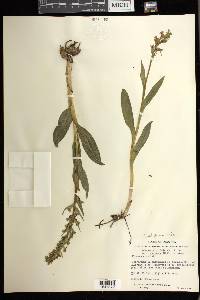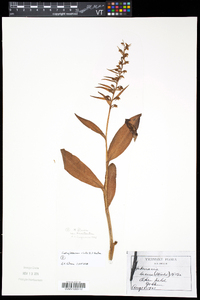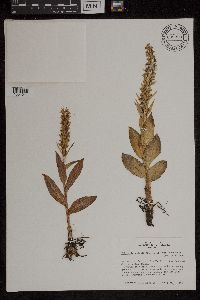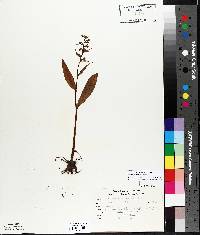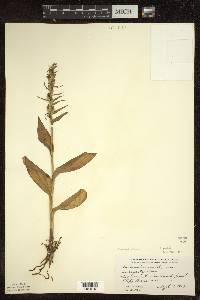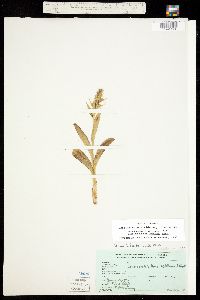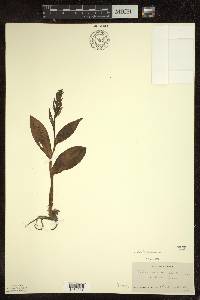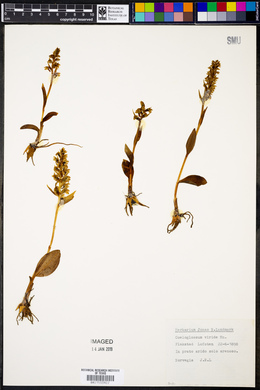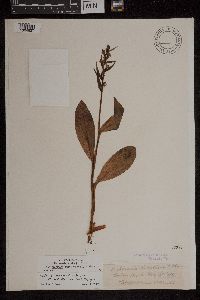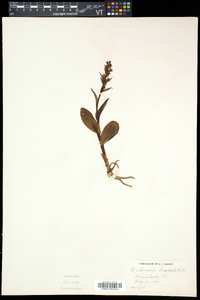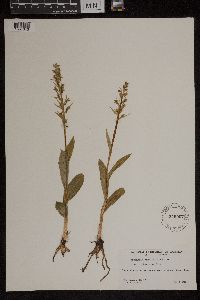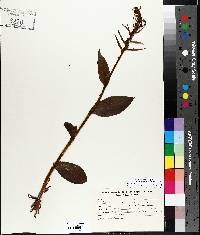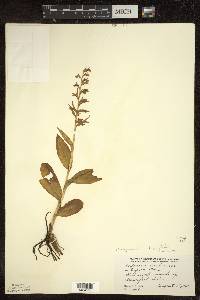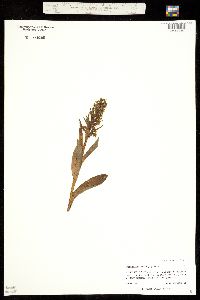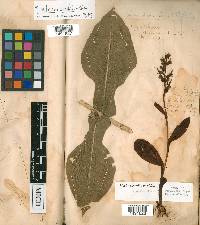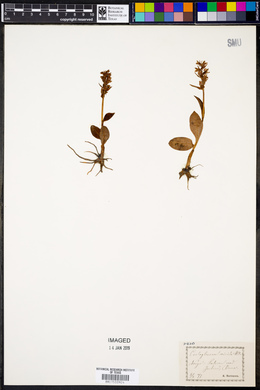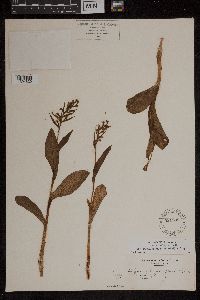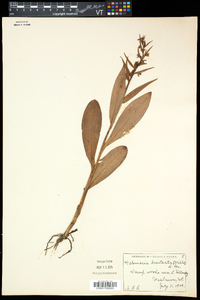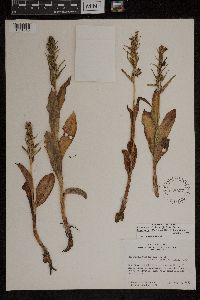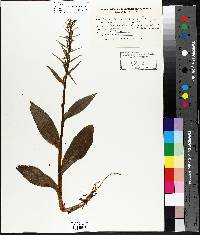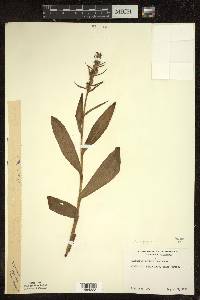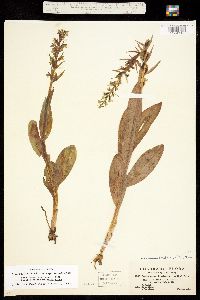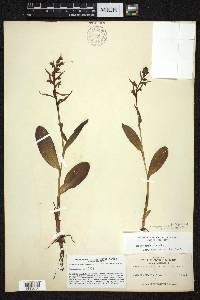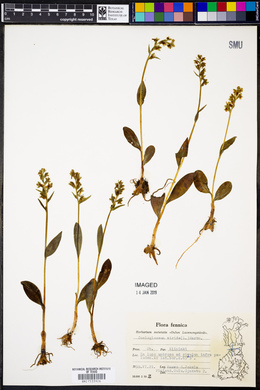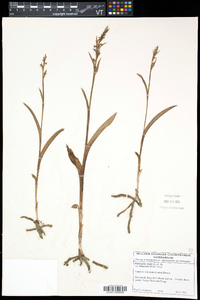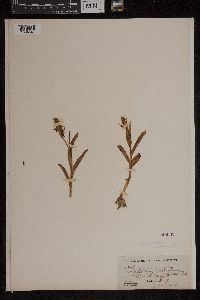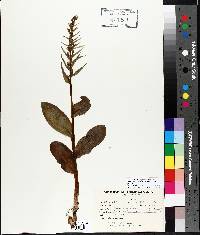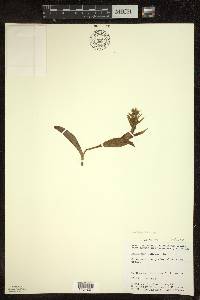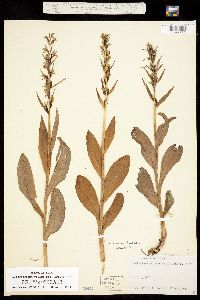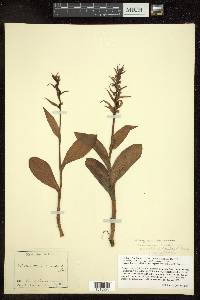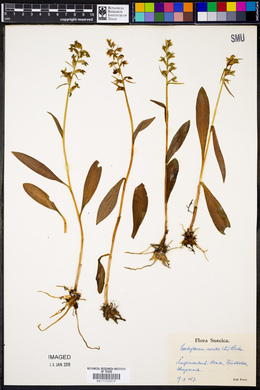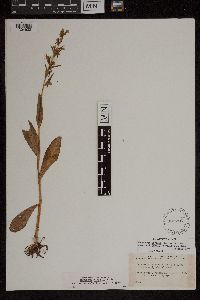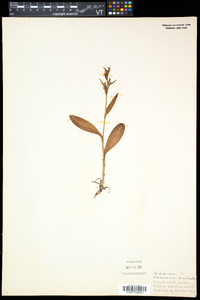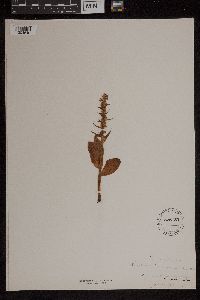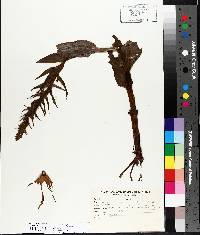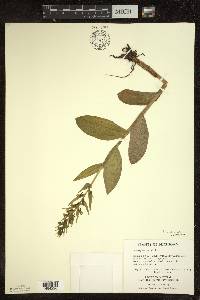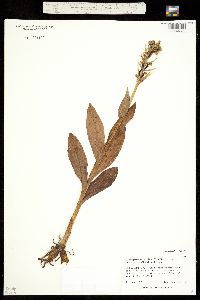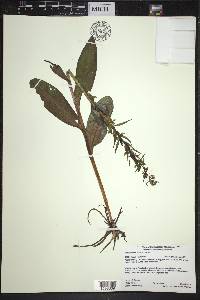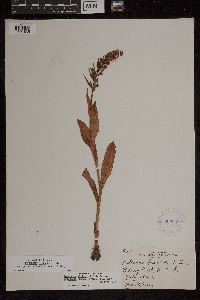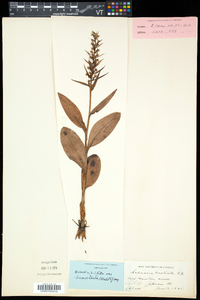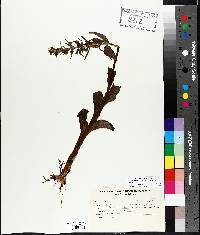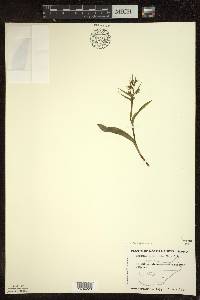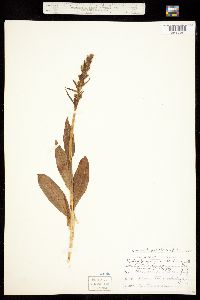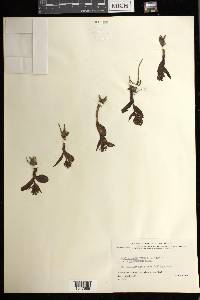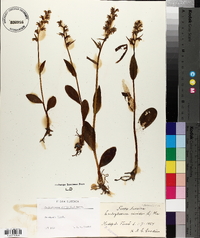Coeloglossum viride
|
|
|
|
Family: Orchidaceae
Long-Bract Frog Orchid
|
Plants 6-80 cm. Leaves 2-several; proximal blades obovate to oblanceolate, the distal oblong-lanceolate, becoming reduced to bracts, 2-18 × 1-7 cm. Inflorescences: floral bracts usually widely spreading, sometimes ascending (especially northward), conspicuous. Flowers greenish, often suffused with dull red or brown; sepals ovate, 3-8 × 2-5 mm, forming hood over column; petals linear, 3-5 × 0.5 mm; lip descending beneath hood, 3-10 × 0.5-4 mm; spur inconspicuous. Capsules 7-14 × 4-5 mm. 2n = 40. Flowering late spring--summer. Moist to wet coniferous and hardwood forests, tundra, prairies, meadows, thickets, coastal heaths, and bogs; 0--2800 m; Alta., B.C., Man., N.B., Nfld. and Labr. (Nfld.), N.W.T., N.S., Ont., P.E.I., Que., Sask., Yukon; Alaska, Ariz., Colo., Conn., Ill., Ind., Iowa, Maine, Md., Mass, Mich., Minn., Mo., Mont., Nebr., N.H., N.J., N.Mex., N.Y., N.C., N.Dak., Ohio, Pa., R.I., S.Dak., Tenn., Utah, Vt., Va., Wash., W.Va., Wis., Wyo.; Eurasia. Recent molecular studies, in which nuclear ribosomal DNA internal transcribed spacer (ITS) sequences were analyzed, showed that within the palmate-tuber clade Coeloglossum is embedded within a strongly supported, monophyletic Dactylorhiza (A. M. Pridgeon et al. 1997); subsequently the monotypic Coeloglossum was formally transferred to Dactylorhiza (R. M. Bateman et al. 1997). The latter authors note that although Coeloglossum differs from Dactylorhiza in many morphologic characters, relatively little molecular divergence has occurred. In this treatment we continue to recognize them as separate but closely related genera. Coeloglossum viride is quite variable across its range, and most American plants are referable to Coeloglossum viride (Linnaeus) Hartman var. virescens (Muhlenberg) Luer. These plants have been distinguished from the largely Eurasian subsp. viride by very long, spreading floral bracts greatly exceeding the flowers. The often large, stout plants with prominently bracted inflorescences and obscure flowers with mostly greenish lips are indeed distinctive. Similar plants also occur in Europe and eastern Asia, however. Small plants referable to subsp. viride, with reduced bracts and few-flowered inflorescences, often with wholly reddish lips, occur in Alaska, where nonetheless most plants are typical of the widespread American plant. Supposedly intermediate plants from the northern part of the American range of the species were described as Habenaria viridis (Linnaeus) R. Brown var. interjecta Fernald. At least in part these differ from long-bracted American plants merely in the long bracts being more nearly appressed to the rachis rather than wide-speading. Very likely the variation in this species should be recognized at some level, but the focus on a single character and its variable expression on different continents does not provide an adequate basis for taxonomy.
Perennial herb 10 - 60 cm tall Leaves: two to four, alternate, stalkless, clasping at the base, non-toothed, 5 - 10 cm long, 2 - 4 cm wide, inversely egg-shaped to inversely lance-shaped (broadest toward the tip), and rather blunt. Inflorescence: a single, erect, terminal, stalked, elongate, tightly arranged spike of eight to fifteen stalkless flowers with each flower subtended by a conspicuous (longer than the flowers), spreading, lance-shaped, 1.5 - 2 cm long, 3 - 4 mm wide, leafy bract. The bracts reduce in size going up the inflorescence, with the upper ones quite smaller and barely longer than the flower. Flowers: green, not showy (under 1.5 cm long), bilaterally symmetric with sepals and lateral petals converging to form hood over fused stamens, stigma and style (column). The lower petal (lip) protrudes downward paralleling the stout ovary, and at its base extends backwards into a sac-shaped nectar spur. Sepals: three, green, 3 - 6 mm long, 2 - 3 mm wide, fairly egg-shaped, and converging with lateral petals to form a hood covering the column. Petals: three, green, upper two linear to lance-shaped, shorter than sepals (3 - 4 mm long, 1 - 1.5 mm wide), and converging with sepals to form a hood. The larger (0.4 - 1 cm long, 2 - 4 mm wide), oblong lip petal is very obvious as it extends sharply downwards like a protruding tongue with two tooth-like triangular lobes at the tip. Base of lip modified into a 1 - 2 mm long, backward projecting, bag-shaped spur. Fruit: several, erect, stalkless, 0.7 - 1.4 cm long, 4 - 5 mm wide, oblong-elliptic, tightly packed capsules in axils of bracts. The capsules are prominently ridged on the angles and have remnant column parts at the apex. Flowering stem: single, erect, hairless, with several leaves, and ending in a tight inflorescence. Root system: of several slender, fleshy, true roots and one or two larger, thickened, tuber-like, forking rootstocks. Similar species: Dried specimens of Coeloglossum viride are commonly confused with Platanthera flava var. herbiola due to the presence of long floral bracts in both species, but flowers of P. flava var. herbiola have a longer spur (5 - 8 mm), and an outward projecting bump or "nose" near the base of the lip. Also, the flowers of P. flava var. herbiola are quite fleshy and often persist into fruit. In sterile plants, P. flava var. herbiola can be distinguished by its relatively narrow, pointed, lance-shaped leaves that are broadest near the base. In addition, while C. viride is usually found as a single plant in more upland habitats, P. flava var. herbiola is a colonial species (typically several to many plants in a population) of swamps and wet prairies. All plants in the Chicago Region are further categorized as C. viride var. virescens (Muhl.) Luer, which are taller and have longer floral bracts than the typical variety. Flowering: early May to mid-June Habitat and ecology: Uncommon, most often in rich mesic woods, wet borders of vernal pools (especially in southern Michigan), and more rarely in swamps, tamarack bogs, and pine woods. Within mesic forests C. viride can be found in a variety of places including the tops of slopes, terraces in ravine valleys, floodplain forests, or forested hills. Occurence in the Chicago region: native Notes: One typically finds C. viride as a single plant, though sometimes another individual (rarely two) may be found in the immediate area. Despite the fairly isolated populations, this species is found worldwide in temperate regions of the northern hemisphere. The genus Coeloglossum is monotypic, meaning it only has one species. Previously believed to be in the genus Habenaria (now known as Platanthera) under the name H. viridis var. bracteata, C. viride has been separated into its own genus due to its forked fleshy tuber-like roots, and a microscopic membrane surrounding the sticky pad-like structure that helps glue pollen packets (pollinia) to visiting insects. Etymology: Coeloglossum comes from the Greek words koilos, meaning hollow, and glossa, meaning tongue, together meaning "hollow tongue" in reference to the short, sac-like nectar spur on the flower. Viride means green, which relates to the green color of the entire plant, including the flowers. Author: The Field Museum |

